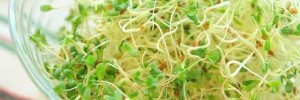Category for Cooking Tips
Preparing sprouts for fresh greens Any whole grain or legume can be sprouted (germinated) into fresh greens. The process of sprouting increases the flavor, palatability, nutrient content, as well as digestibility. Sprouting releases enzymes such as alpha-amylase that break down the starches into more readily digestible sugars. The sprouting procedure starts with a jar equipped […]
Read the rest of this entry »Preparing Legumes Legumes are best prepared by simmering rather than boiling. One cup (1/2 pound) of dried beans usually yields 2 to 2 1/2 cups of cooked beans; 1/2 cup of cooked dried beans or peas may be counted as a 1-ounce serving of meat or as one vegetable serving. Cooked legumes can be eaten […]
Read the rest of this entry »Preparing vegetables using the moist-heat Cooking by simmering Vegetables should not be boiled, but instead simmered in as little water as possible to avoid nutrient loss and adverse effects on flavor, texture, and color. To simmer, vegetables (with the exception of potatoes) are added to lightly salted boiling water; when the water starts to return […]
Read the rest of this entry »Dry-Heat Preparation of Vegetables Baking Vegetables Some vegetables – especially potatoes, winter squash. onions, stuffed green peppers, and tomatoes – can be baked whole at approximately 350°F (177°C). Increasingly popular are roasted vegetables such as peppers, onions, and eggplant, which are generally sprinkled with oil and roasted at 375° to 425°F (191° to 218°C) until […]
Read the rest of this entry »General guide on vegetables preparation Vegetables can be prepared by dry-heat (baking, roasting, sauteing, or deep-fat frying) or moist-heat (simmering, steaming, or microwaving) methods, and can be served plain, buttered, creamed, au gratin, glazed, scalloped, stuffed, or in souffles, omelets, and cream soups. Regardless of the cooking method or serving style selected, some general principles […]
Read the rest of this entry »Legumes Beans, peas, and lentils serve as excellent sources of fiber, protein, iron, and complex carbohydrates. The single common identifying factor among all legumes is that they grow as seeds within a pod. Dried beans have served as a dietary staple since the Bronze Age. Soybeans are unique in that, compared to other plant sources, […]
Read the rest of this entry »Types of onions The most common onion varieties are yellow, white, red, and green. The yellow onion, which is the general all-purpose onion, should feel firm, the skin should be dry and papery, and the stem small. The skin should be free of any green sunburn marks, mold, or blackish decay spots. A typical fresh […]
Read the rest of this entry »The various types of potatoes – Potatoes Numerous potato varieties are cultivated in South America, but in North America, three basic types are found in the market: Russet/Idaho, white, and red. Russets are considered starchy potatoes and are preferred for baking, whites are best suited for roasting with meats or poultry, and reds, known as […]
Read the rest of this entry »Choosing the various types of vegetables Vegetables are from living plants that grow in cycles with the passing seasons. Thus, the season of the year is the most important consideration when selecting vegetables. Not all vegetables are in season at the same time, and they need to be picked accordingly to maximize quality. Selecting an […]
Read the rest of this entry »How are vegetables classified? Vegetables may be derived from almost any part of a plant: roots (carrots, beets, turnips, and radishes), bulbs (onions and garlic), stems (celery and asparagus), leaves (spinach and lettuce), seeds (beans, corn, and peas), and even flowers (broccoli and cauliflower). In addition, there are foods that are routinely called vegetables and […]
Read the rest of this entry »